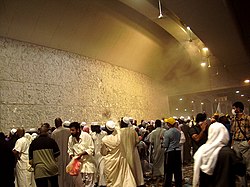Hajj

The Hajj ("pilgrimage") is an annual Islamic pilgrimage to Mecca, the most holy city of the Muslims. It is a Fard, a religious duty for Muslims that must be carried out at least once in their lifetime by all adult Muslims who are physically and financially capable of undertaking the journey, and can support their family during their absence.[1][2][3] It is one of the five pillars of Islam, alongside Shahadah, Salat, Zakat, and Sawm. The Hajj is the largest annual gathering of people in the world.[4][5] The state of being physically and financially capable of performing the Hajj is called istita'ah, and a Muslim who fulfills this condition is called a mustati. The Hajj is a demonstration of the solidarity of the Muslim people, and their submission to God (Allah).[6][7] The word Hajj means "to intend a journey", which connotes both the outward act of a journey and the inward act of intentions.[8]
The pilgrimage occurs from the 8th to 12th (or in some cases 13th[9]) of Dhu al-Hijjah, the last month of the Islamic calendar. Because the Islamic calendar is lunar and the Islamic year is about eleven days shorter than the Gregorian year, the Gregorian date of Hajj changes from year to year. Ihram is the name given to the special spiritual state in which pilgrims wear two white sheets of seamless cloth and abstain from certain actions.[6][10][11]
The Hajj is associated with the life of Islamic prophet Muhammad from the 7th century, but the ritual of pilgrimage to Mecca is considered by Muslims to stretch back thousands of years to the time of Abraham. During Hajj, pilgrims join processions of hundreds of thousands of people, who all go to Mecca for the week of the Hajj, and perform a series of rituals: each person walks counter-clockwise seven times around the Ka'aba (the cube-shaped building and the direction of prayer for the Muslims), runs back and forth between the hills of Al-Safa and Al-Marwah, drinks from the Zamzam Well, goes to the plains of Mount Arafat to stand in vigil, spends a night in the plain of Muzdalifa, and performs symbolic stoning of the devil by throwing stones at three pillars. The pilgrims then shave their heads, perform a ritual of animal sacrifice, and celebrate the three-day global festival of Eid al-Adha.[12][13][14][15]
Pilgrims can also go to Mecca to perform the rituals at other times of the year. This is sometimes called the "lesser pilgrimage", or Umrah.[16] However, even if they choose to perform the Umrah, they are still obligated to perform the Hajj at some other point in their lifetime if they have the means to do so, because Umrah is not a substitute for Hajj.[17]
As an industry
Saudi Arabia's economy greatly benefits from Hajj tourism and has invested in hotel businesses as well as infrastructure to accommodate and profit from Hajj and Ummrah tourism.[18]
Hajj Media
A 1907 photograph of people praying near the Kaaba in the Great Mosque of Mecca
Tawaf. During the Hajj , are to circumambulate the Ka'bah (the holiest building in Mecca) seven times, in a counterclockwise direction.
Direction of the tawaf around the Kaaba
Air-conditioned tents for Hajj pilgrims in Mina, Saudi Arabia, 2 kilometres (1.2 mi) away from Mecca
References
- ↑ Long, Matthew (2011). Islamic Beliefs, Practices, and Cultures. Marshall Cavendish Corporation. p. 86. ISBN 978-0-7614-7926-0. Retrieved 2 September 2014.
- ↑ Nigosian, S. A. (2004). Islam: Its History, Teaching, and Practices. Indiana: Indiana University Press. p. 110. ISBN 978-0-253-21627-4.
- ↑ Berkley Center for Religion, Peace, and World Affairs - Islam Archived 2011-10-02 at the Wayback Machine See drop-down essay on "Islamic Practices"
- ↑ Mosher, Lucinda (2005). Praying: The Rituals of Faith. Church Publishing, Inc. p. 155. ISBN 978-1-59627-016-9. Retrieved 18 September 2014.
- ↑ Katz, Andrew (16 October 2013). As the Hajj Unfolds in Saudi Arabia, A Deep Look Inside the Battle Against MERS. Time. http://science.time.com/2013/10/16/as-the-hajj-unfolds-in-saudi-arabia-a-deep-look-inside-the-battle-against-mers/. Retrieved 17 October 2013.
- ↑ 6.0 6.1 Nigosian, S. A. (2004). Islam: Its History, Teaching, and Practices. Indiana: Indiana University Press. p. 111. ISBN 978-0-253-21627-4.
- ↑ Hooker, M. B. (2008). Indonesian Syariah: Defining a National School of Islamic Law. Institute of Southeast Asian Studies. p. 228. ISBN 978-981-230-802-3. Retrieved 6 October 2014.
- ↑ Adelowo, E. Dada, ed. (2014). Perspectives in Religious Studies: Volume III. Ibadan: HEBN Publishers Plc. p. 395. ISBN 978-978-081-447-2.
- ↑ "13th of Zil Hajj". heliohost.org. Archived from the original on 2019-10-28. Retrieved 2016-11-30.
- ↑ "ihram". Encyclopædia Britannica. 2014. Retrieved 6 October 2014.
- ↑ "Ihram - Summary". Hajj Portal. Archived from the original on 21 July 2008. Retrieved 20 November 2013.
- ↑ Armstrong, Karen (2002). Islam: A Short History. Modern Library Chronicles (Revised Updated ed.). Modern Library. pp. 10–12. ISBN 978-0-8129-6618-3.
- ↑ Anisa Mehdi; John Bredar (2003). Inside Makkah (video documentary). National Geographic Society.
- ↑ "Eid ul Adha". BBC. 7 September 2009. Retrieved 30 December 2012.
- ↑ Sahih Bukhari-hadith No-732-733
- ↑ "Saudi Arabia to move from oil, earn more from Hajj". RussiaToday. 25 March 2016.
- ↑ Matt Stefon, ed. (2010). Islamic Beliefs and Practices. New York: Britannica Educational Publishing. p. 73. ISBN 978-1-61530-060-0.
- ↑ "Saudi Arabia's multibillion-dollar hajj industry is getting smarter than ever".






